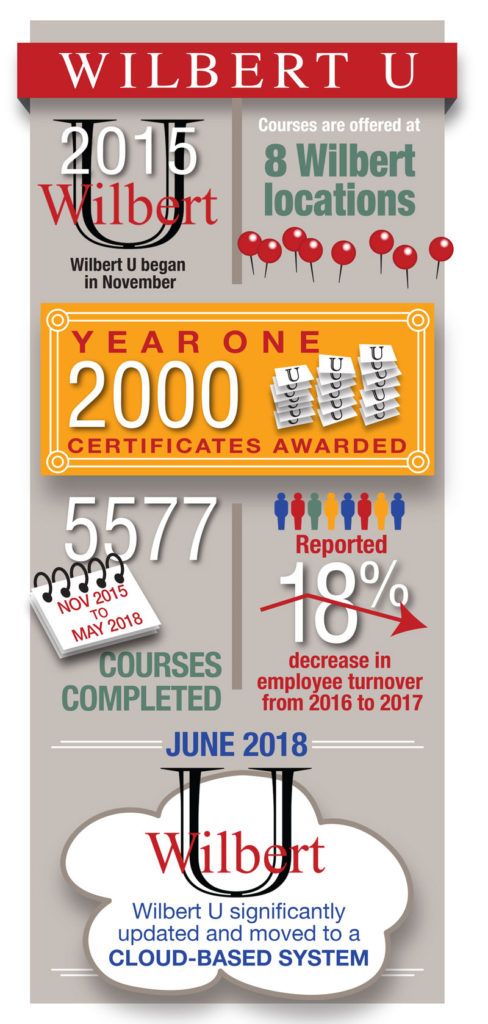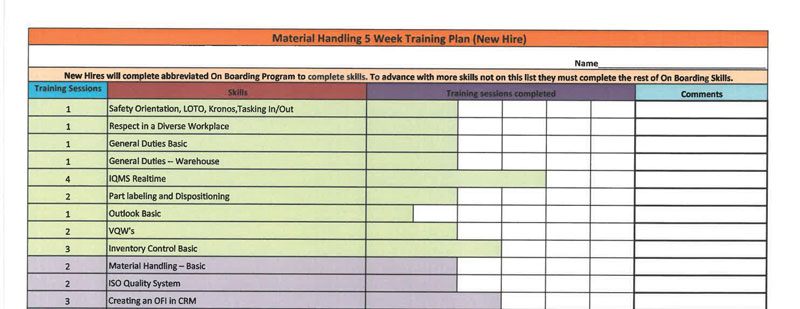by Elizabeth Stevens, contributing writer
Plastics Business
In the plastics industry, as in every industry, people are among a company’s most valuable assets. Three companies in the industry – a molded parts producer, a custom extruder and a custom injection molder/thermoformer – have shown their belief in this principle by investing in and implementing best practices in training and career advancement. Their investments have paid off handsomely, with results that include increasing the ability to attract employees, closing the skills gap, upping retention for new hires, standardizing company-wide training and establishing clear career advancement paths for valued employees.
The companies have work forces ranging from 100 employees to 1,250 employees. They have created training and advancement programs specific to each company’s identity and human resource needs. Plastics Business asked Engineered Profiles, Nicolet Plastics and Wilbert Plastics Services to share details of their experiences in identifying the need for new programs, the ways in which they defined the employees eligible for participation, challenges that occurred in implementation, measurable benefits, unexpected results and stand-out employee stories.
Skills matrix establishes training, advancement paths
Engineered Profiles LLC, Columbus, Ohio, is a producer of custom plastics extrusions, employing 250 full-time associates. Brad Lamone, vice president of workforce development, described the company’s customers as OEMs in a variety of different industries, including fenestration, building products, agriculture, transportation, energy and appliances. Three years ago, when Engineered Profiles’ mentor-based training system was assessed as inconsistent and the company lacked a formal advancement plan, management decided to create an extrusion-specific training system.
The initial goal was to take a new employee with no extrusion experience to the level of running a production line solo in three to six months. But, after first focusing on production associates, Engineered Profiles expanded its program to include warehouse/material handling, fabrication, tool and die, and maintenance departments, with all training as paid time.
As Lamone explained, “The program, which we call a skills matrix or career road map, allows us to show a new hire on their first day of employment how to advance in their role, along with the required training. They see what is required to go from an operator trainee to senior technician in terms of training and compensation.”
The skills matrix breaks down specific training, tasks and requirements to advance in each department. At hiring, production trainees take “Extrusion 101,” a six-week classroom and hands-on program. Employees then may take additional classes to advance, based on their own initiative. (Salaried associates also take Extrusion 101 so that all employees understand the extrusion process and its terminology.) The skills matrix and current status of every worker at Engineered Profiles is posted in the facility, adding transparency to the company’s promotion system.
“The biggest challenge we faced was establishing the correct skills criteria for every position in the company,” Lamone said. “This took a significant amount of time and required assessing the skill level of all current associates.”
The company identified a few employees who did not meet all of the skill requirements for their current positions. They were given a year to gain required skills, with no demotion or loss of pay. While there was initial pushback from some senior employees who felt that tenure gave them an automatic right to their positions, pushback faded when employees saw that the program was designed to be objective, with clear paths for advancement and raises.
Engineered Profiles has seen distinct benefits. “There is no doubt our training program is a competitive advantage for us in a very tight labor market,” Lamone said. “Showing potential new hires a clear path to earn more money and advance sells very well during the interview process.” The reduction in the gap between unskilled and skilled employees also is impressive. “Since expanding the skills matrix to all operational areas, we virtually have no unskilled labor working for the company,” Lamone explained.
Retention at the one-year mark for new hires who completed Extrusion 101 is almost 80%. The skills matrix has added consistency to training and eliminated the potential for favoritism. The advancement path for employees is evident: During the first six months of 2018, 44 employees earned pay increases, averaging $1,834 annually, by participating in the program.
One unexpected result is some healthy competition among Engineered Profiles employees. “Associates want to advance quicker or at the same pace as their co-workers,” Lamone said. “Our associates genuinely appreciate the recognition they receive from our leadership team at our quarterly shift meetings.”
One employee who embraced the training opportunities, benefitting himself and the company, is an individual who advanced from trainee to technician in only 18 months, far surpassing the usual four-year timeframe. Lamone cited the employee’s motivation: “This associate wanted to make a technician’s pay as quickly as possible and did everything he could to make that happen. He now is working to become a senior technician, which is our highest paid position.”
Quarterly meetings provide checkpoints for six career paths

Nicolet Plastics employs 100 individuals in its Mountain and Jackson, Wisconsin, locations. In business for 30 years, the company produces plastic molded parts for the medical, electronics, agricultural, industrial, consumer, dental and sporting goods industries.
Human Resources Manager Lisa Pichotta described the company’s impetus for creating a training program: “Due to our small community located in the Chequamegon Nicolet National Forest, skilled talent was not as easily attainable as in larger communities. We set out to create a training program that would allow us to up-skill our workforce and also cross-train to allow more flexibility to successfully deliver quality parts for a very diverse customer base.”
Nicolet’s training program has been in place for several years, but it continues to evolve. “We have found as our employee demographics change, so do learning styles and the needs of our employees,” Pichotta said.
Nicolet’s program uses an individual development plan (IDP), created following a welcoming period during which employees learn the foundations for success at the company. To create the IDP, the employee, human resources manager, training coordinator and supervisor meet to discuss each employee’s expectations for their roles and how they would like to grow. All employees have quarterly IDP meetings.
A new employee has six career paths from which to choose, each with specific skills and a training plan that ranges from three weeks to more than a year. The skills matrix for the production department, for example, lists more than 88 skills, with point values assigned based on skill complexity. “For every 10 training points an employee is competent and confident in performing, they are able to earn an additional 50 cents per hour,” Pichotta said. “Self-motivated employees are able to move up and increase their hourly wage fairly quickly.”

Pichotta explained that the biggest challenge in implementing the program was “getting everyone on board with a standard approach to training and then, of course, the struggle of production vs. training. The HR team and production leadership team for all shifts meet monthly to identify priority training based on our gaps and how we will work together across the shifts to accomplish our goals,” she said. Nicolet posts weekly training schedules throughout its facilities.
“The employees who have been most successful in their quest to gain additional skills are those who were flexible to come in for training on weekends and off-shifts for the opportunity to learn specific skills that may not have been easily attainable on their normal shift,” she continued.
Nicolet Plastics has reaped rewards from the training and advancement plans. “We often have a pipeline of new employees waiting to join our team,” Pichotta said. “We have a daily visual of our skills gap and progress in closing it. At the end of June 2016, we were only at 53% of our ideal talent level, compared to 90% a year later. Increasing our skills level has allowed us to go from four or five 12-hour shifts to four 10-hour shifts. In 2016, the largest category for turnover was a result of no call, no show (NCNS). In 2018, we have not had any NCNS. As of today, we are retaining 81% of new hires within their first year of employment. Training Within Industry – Job Instructions training has helped us create standard training and trainers. And, when an employee signs up for a new role they know exactly what the time commitment and expectations are before they accept the role.”
Most employees have embraced the program, with many standout examples. “We have an employee who joined our team right out of high school, without any manufacturing background, who is an awesome process tech – Level 1 today,” Pichotta said. “We have two former production employees who are pursuing leadership roles. I could go on and on.”
Cloud-based learning pushes consistency across facilities
Established in 1965, Wilbert Plastics Services is headquartered in Belmont, North Carolina. The company does custom injection molding and heavy-gauge thermoforming for the automotive, medical equipment, appliance, heavy truck, heavy agriculture and consumer products industries, and has 1,250 employees in manufacturing plants and engineering centers in North Carolina, South Carolina, Minnesota, Ohio and Kentucky.
According to CEO Greg Botner, implementing a training program stemmed from Wilbert’s multiple locations. While the company had partnered with some technical schools and community colleges for localized training support, Botner said that creating their own training program enabled them to address needs in all locations. “We still coordinate with local technical school and colleges to tap into outside training programs where it’s practical, and we do engage them for higher level training in electronics or hydraulics,” he said.
Wilbert’s program started in 2012 with a canned process-oriented training program. Initially using a training center with computers where employees were paid to take task-specific courses, the company expanded training to reach all employees, with mandatory initial training as well as courses for employee advancement. “What motivated us first was the shortage of employees with the skill set we needed to run our plant and, second, the engagement that we saw early on with the program,” Bottner explained. “People started asking for more, so we broadened the program. That’s when we adopted the name Wilbert U, a takeoff of Wilbert University.” After focusing on individual skills, Wilbert widened its courses to cover complete jobs and, eventually, all of the systems used by the company.
The main implementation challenge was that sidelining employees for training affected scheduling and production, causing problems for department managers. Wilbert addressed this with cloud-based training that can be accessed anywhere, anytime.
Botner explained that Wilbert U is a continually evolving program covering technical skills, leadership programs, operating system modules and even “day in the life” profiles, most of which are in video form and many of which are created in-house. He credited Amelia Keown, a Six Sigma black belt certified trainer, for managing and championing Wilbert U: “If you don’t have a full-time champion to do it, it’s not going to get done.”
The most unexpected result of implementing their training program is that, in an industry with repetitive production work, the program has invited employees to understand the overall process to which they contribute, engaging people by making their work more meaningful and interesting. Wilbert has seen its program pay off in attracting new employees, in an 18% improvement in retention rate and in empowering motivated employees to advance.
Wilbert Plastics Services has seen virtually no employee pushback, and Botner explained that the training program has been embraced widely and also highlighted by local news media. “One standout employee that really jumps to my mind is a woman in our Bellevue, Ohio, plant, Melissa McLauglin,” he said. “Over the last five or six years, she has moved up from a machine operator level to program manager – a high-level engineering job – for some of our Ford Motor Company programs.”
Engineered Profiles, Nicolet Plastics and Wilbert Plastics Services are leaders in using employee training programs to enhance their companies. As Wilbert’s Greg Botner summed up: “I have become a believer that if you don’t have an effective training program for your employees these days, then your business is in jeopardy.”





